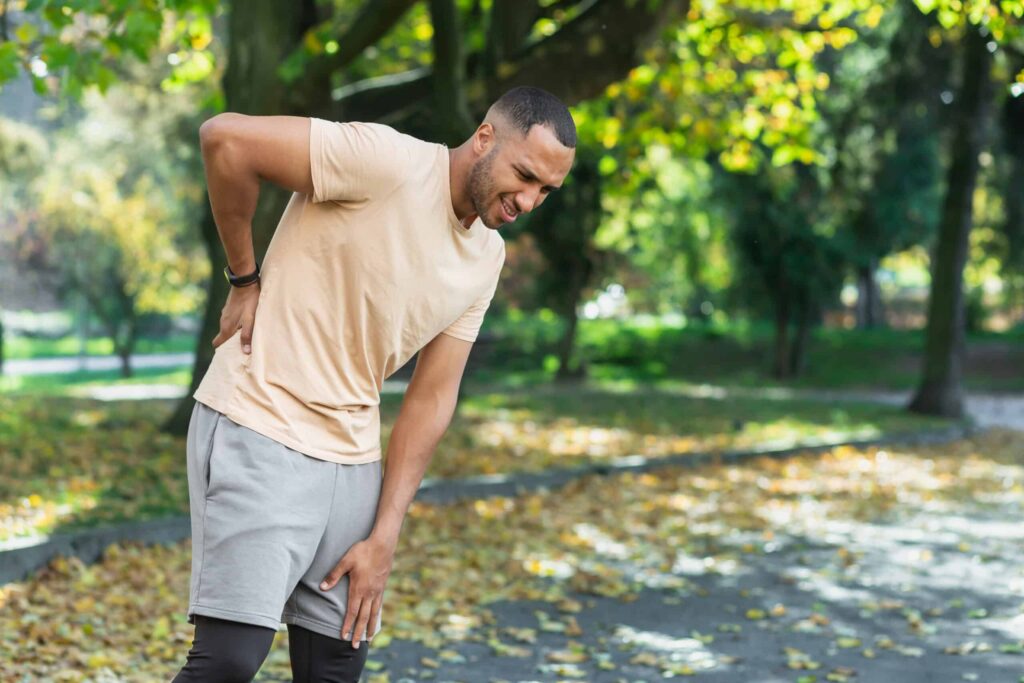This content was updated for accuracy and relevance on 01/03/24
You’re out for a run and the temperature is perfect, your pace is great, you’re on the verge of experiencing that runner’s high when you feel it coming on – that sharp pain in your side that’ll stop you in your tracks. You’ll take blisters, rain, and even intense heat over the dreaded side stitch also referred to as a runner’s cramp. Sometimes it’s a mere annoyance but other times it can be so severe that it’ll have you doubling over in abdominal pain.
What causes muscle cramps and side aches when running?
Many sports med experts refer to a side stitch as “exercise-related transient abdominal pain” or ETAP, and while there are some strong theories on what brings it on, the exact cause of a side stitch while running or exercising is unknown.
One sport theory suggests that a running side stitch happens as a result of a muscle spasm in your diaphragm. Your diaphragm muscle, which is located right below your lungs, serves as the main respiratory muscle, and it can get fatigued, just like any other muscle. If you’re new to running, or you’re running at a pace faster than normal, you may be putting a lot of extra stress on your respiratory system as you breathe deeper and faster during a hard workout. Rapid, deep breathing causes your lungs to place downward pressure on your diaphragm. This, combined with increased abdominal pressure pushing up on your diaphragm, pinches the muscle, causing a painful side stitch. Weak abdominal muscles might also play a role because your body relies heavily on its core to stabilize each stride as you run.
We find that less experienced or younger athletes are more likely to experience side stitches during physical activity. As your muscles and core get stronger, and you build stamina it seems a side muscle cramp is less likely. However, athletes and experienced runners can certainly still get the occasional and dreaded side stitch.
How do you get rid of a stitch in your side, mid run?
When you feel a side stitch coming on, try these steps to resolve the cramps:
- Stop running and focus on deep breathing.
- Gently press your first two fingers slightly upward towards the pain and hold them for about 10 seconds while keeping a consistent breathing pattern.
- Continue your breathing rhythm and press around the painful area. Within a few minutes, the pain should subside.
- Try stretching to relieve the muscle cramp. If the pain is on your right side, raise your right-hand overhead and gently bend your torso in the opposite direction of the pain until you feel a gentle stretch. This movement stretches the abdominal muscle where you feel the stitch.
- When the side stitch pain begins to ease up, start walking and gradually work your way back up to a full-pace run.
Can a side stitch last for days?
Side stitch pain will usually go away on its own after a few minutes or when you stop exercising. If your pain persists for several hours, or does not go away after you stop exercising, you may need to seek the advice of a medical professional. If your sharp pain is joined by a fever or swelling, seek emergency help right away.
How to prevent a side stitch or cramp while running
If you’ve had side stitch pain before and were able to relieve it by using the methods noted above, you may be wondering how to prevent them from coming back the next time you’re out for a run. Here are a few tips to prevent a side stitch:
- Avoid eating one to two hours before running
- Keep pre-workout meals small
- Avoid fatty and high-fiber foods before your run
- Practice a proper breathing technique through pursed lips
- Consider leg therapy
- Avoid sugary beverages before a run
- Increase your water intake throughout the day
- Warm up and stretch well before running
- Pace yourself by slowly increasing your speed; side cramps can be a sign that your body is overwhelmed
- Shorten the length of your workouts
- Improve core strength
- Remember to breathe, it will help relax the diaphragm
Learn more tips on how to prevent running injuries.
Is a side stitch bad?
Even though they may be painful, a side stitch is generally pretty harmless. Listen to your body and slow down when you feel discomfort coming on. Once it goes away you can continue on at your normal pace. The good news is that many people find that side stitches are less common as their stamina and general fitness levels increase.
How can a physical therapist help with side stitches?
If you have chronic and severe side stitch pain, you might consider setting up a physical therapy appointment so a therapist can assess your posture, spine, and core stability. A physical therapist can show you the right breathing technique to help release and relax your diaphragm and abdominal tissues. We’ll also look at dynamic stretches for your neck and back muscles.
In general, proper posture while standing, walking, and running can be very beneficial in taking some of the stress off the neck muscles and nerves. By improving your breathing pattern, blood flow, and strengthening the core muscles around the abdomen, back, and neck, we can help to reduce or eliminate the chances of side muscle or cramp in the future.
At Ivy Rehab, we also offer an exceptional running analysis program where you’ll meet with a physical therapist who will tailor an exercise program specific to you and your running needs. The program is ideal for anyone who wants to improve their running performance, but it doesn’t just apply to athletes and experienced runners looking to improve their personal records or run longer distances. Patients who suffer from lower extremity injuries such as the knee, leg, hip, ankle, or foot pain can benefit as well.
If you have any questions on severe side stitch pain, leg cramps, proper breathing techniques, or sports injury screenings, feel free to request an appointment at an Ivy Rehab Network location near you.
The Bottom Line
Thankfully, side stitches are not serious, and there are ways to remedy and prevent the cramps from happening during your run. Hydrating, breathing exercises, and warming up before your workout can help. The cramping and pain should resolve within a few minutes but if it persists for a few hours, seek treatment using physical therapy.
Article Reviewed by Holly Lookabaugh-Deur, PT, DSc, GCS, CEEAA
Holly Lookabaugh-Deur, PT, DSc, GCS, CEEAA is a practicing physical therapist and a partner and Director of Clinical Services at Ivy Rehab Network. Deur is board certified as a geriatric clinical specialist and certified exercise expert for aging adults with more than 35 years of clinical experience. She is certified as an aquatic and oncology rehabilitation specialist and serves as adjunct faculty at Central Michigan University and Grand Valley State University.







